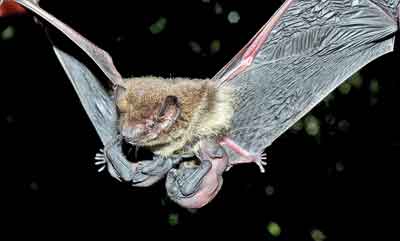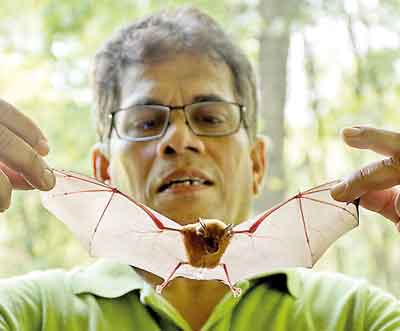Hooked on bats
A painting and a sketch encapsulate it all.

A bat in flight carrying a baby
The 1850 painting by William-Adolphe Bouguereau of ‘Dante and Virgil in Hell’ depicts a horrific winged-monster hovering in the background.
Much-maligned and stigmatized are bats with numerous unkind epithets including vampires encircling them, with some politicians in Sri Lanka being linked derogatorily with ‘wavul prathipaththi’ or as having the dicey principles of a bat.
This image, however, changes when you pick up ‘A Field Guide to the Bats of Sri Lanka’ by Prof. Wipula Bandara Yapa.
Published by Dilmah Conservation, this reader-friendly slim book is packed tight with information, photographs, sketches and even figures depicting the novel echolocation ability of bats.
The Field Guide takes these bats hanging upside down in the deepest and darkest caverns and holds them up to the light to endear them to us and pinpoint the vital role they play in restoring and conserving the ecosystem.
As a child, having to clean up the litter of half-eaten fruits around the garden of his home in Palansena, Kochchikade, made bats fall foul of Dilmah Conservation Founder Merrill J. Fernando but with fewer and fewer of these flying mammals being seen due to trees being cut down, he has come to appreciate the “incredible” roles they play as pollinators, seed-dispensers and pest-controllers.
With the hope of arming the younger generation with knowledge on “this well-known but less well understood” species flying down from 50 million years ago that Dilmah Conservation turned its sights on Chiropterologist Yapa who is Professor in Zoology and Head of the Department of Zoology and Environment Sciences of the University of Colombo. He is well-versed in all-things to do with these animals as his Master’s Degree was on cave-dwelling bats. He has carried out a detailed survey of them and looked closely at their breeding habits, roosting ecology, migration, social behaviour and pathogens.

Prof. Wipula Bandara Yapa
As a young graduate though Prof. Yapa was no lover of bats.However, stumbling into Wavul Galge in Wellawaya, his first-ever visit to a cave immersed in absolute darkness, accompanying a visiting academic from Germany, Prof. Rudolf Rubsamen, and seeing the out-flight of thousands of these creatures had got him hooked forever.
He learnt the art of handling these “aggressive” little creatures from Prof. Rubsamen and urges people never to attempt to handle a bat unless trained to do so and if by chance a bite occurs to seek immediate medical advice.
With most of us assuming that bats are black, he picks out the brightly-coloured ones – painted bat (Kerivoula picta) which sports bright orange or tawny red and Rufous horseshoe bat (Rhinolophus rouxii) which is dull brown, ranging from yellow to bright orange.
Interesting details all found within the Field Guide which describes 30 species emerge: Bats are either frugivores feeding on fruits, nectar, leaves, flowers and pollen or carnivores preying on insects, fish, flesh and blood and sometimes geckos, larger frogs, birds, rodents and even other species of their own kind.
Prof. Yapa talks of the morbid fascination that humans have with ‘vampire’ bats fuelled by all the Dracula movies. “There are notorious vampire bats which exclusively feed on the blood of other animals,” he says, adding that it is not recorded that they feast on human blood. However, these are not found in Sri Lanka.
Another unique feature of a bat is echolocation, a series of short, high-pitched sounds emitted from the larynx which travel out and bounce off objects and obstacles in the animal’s path, creating an echo, helping bats to navigate in pitch darkness.
If all this does not make us fans of bats, Prof. Yapa plays his trump to convince us………“Walk into a cave bathed in absolute darkness and see a thousand stars illuminating the blackness in there. These are the eyes of the fruit bat (Rousettus leschenaulti).”
This star-spangled darkness has enticed Prof. Yapa who is sure that we too will follow their light into the fascinating but secret world of bats.
| Book launch tomorrow | |
| A Field Guide to the Bats of Sri Lanka will be launched tomorrow (November 27) at the Home of Dilmah at Peliyagoda. Priced at Rs. 350, the Field Guide is available at the Dilmah t-Lounges and the Dilmah tea Boutique at Crestcat. |


